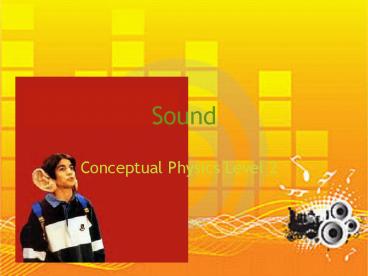Sound PowerPoint PPT Presentation
1 / 14
Title: Sound
1
Sound
- Conceptual Physics Level 2
2
Review
- There are ______ types of mechanical waves.
- They are called _____________waves and
________________waves
- ___________________ waves have oscillations that
are perpendicular to the direction the wave
travels.
- They have high points _______ and low points
__________.
- ___________________ waves have oscillations that
are parallel to the direction the wave travels.
- They have close regions _____________ and far
apart regions ____________________.
3
Sound
Sound is the result of longitudinal waves passing
though a medium.
- It is the result of compressed and rarefied
regions of air. This movement of energy through
the air is what caries sounds to you.
Also, the compressed regions are high pressure
and the rarefied regions are low pressure.
- A great way to look at how air is compressed and
rarefied is by looking at what happens when you
open and close a door in a room with an open
window.
4
Pitch
Pitch is a result of how our ears interpret the
varying frequencies of a sound wave. The higher
the pitch, the higher the frequency. The human
ear can hear ranges of pitch from low notes
around 20Hz to high notes around 20,000Hz.
However, as a human ages, he/she loses hearing
and in turn loses the ability to distinguish
between different pitches. How good is your
hearing?
- Frequencies below 20 Hz are known as infrasonic.
- Frequencies above 20,000 Hz are known as
ultrasonic
5
Loudness
- Loudness depends on the amplitude of the sound
wave. The greater the amplitude, the louder the
sound appears to us. - this is measured in decibels (dB)
- But loudness is related to amplitude and
frequency. - Because of the way our ears work, two sounds can
sound just as loud with different amplitudes and
frequencies.
6
Superposition
- Sound is most often made of more than one
frequency. - for example human voices have more than one
frequency (wave) - When more than one wave is present, the
superposition principle states that the total
vibration at any point is the sum of the
vibrations from each individual wave.
7
Speed of sound
- Sound moves at different speeds in different
mediums (types of matter).
- sound travels faster in liquids than air
(gases) - sound travels faster in solids than
liquids
- Why do you think this is?
- Let's see if you're educated guess was right!!!
What is the speed of sound? _____________________
___
8
Speed of sound
- Air at 20 C 340 m/s
- lower temperature slows sound
- 0 C 330 m/s
- Speed of sound in water
- 4 times faster than in air
- Speed of sound in steel
- 12 times faster than in air
But what is the speed of sound in a vacuum?
9
ZERO! SOUND CANNOT TRAVEL IN A VACUUM. IT NEEDS A
MEDIUM TO GO THROUGH!
10
Doppler Effect
The Doppler Effect occurs for an observer when a
body emitting a wave is moving relative to the
observer. It is the apparent change in frequency
caused by the movement of the source relative to
the receiver
Example
Note It has NOTHING to do with
loudness!!!!!!!!!!!!!
11
Exceeding the wave speed
Normal Doppler Effect
Normal Waves
Same speed as wave
Faster than the wave (Bow Wave)
12
Bow Waves The two dimensional wave pattern you
get when the source of a wave matches or exceeds
the speed of the wave fronts. Ex the waves
that flow from the side of a speed boat.
Shock Wave The three dimensional wave pattern
you get when a source travels faster than the
wave front most often occurring in air. Ex Sonic
booms from planes, snap of a whip
13
Forced Vibration the vibration of an object that
is made to vibrate by another vibrating object
that is nearby. Natural Frequency the
frequency at which an elastic object will vibrate
once you put energy into it. Very little energy
is needed to make something vibrate at its
natural frequency.
Tacoma Narrows Alternate Why does the Tacoma
Narrows Bridge break?
14
Resonance
When energy is added to an oscillating object
at its natural frequency this will cause the
amplitude of the wave in the material to grow
very big. It does not take a lot of effort to
do this. Natural frequency is also known as
Resonant Frequency Wine Glass Example

